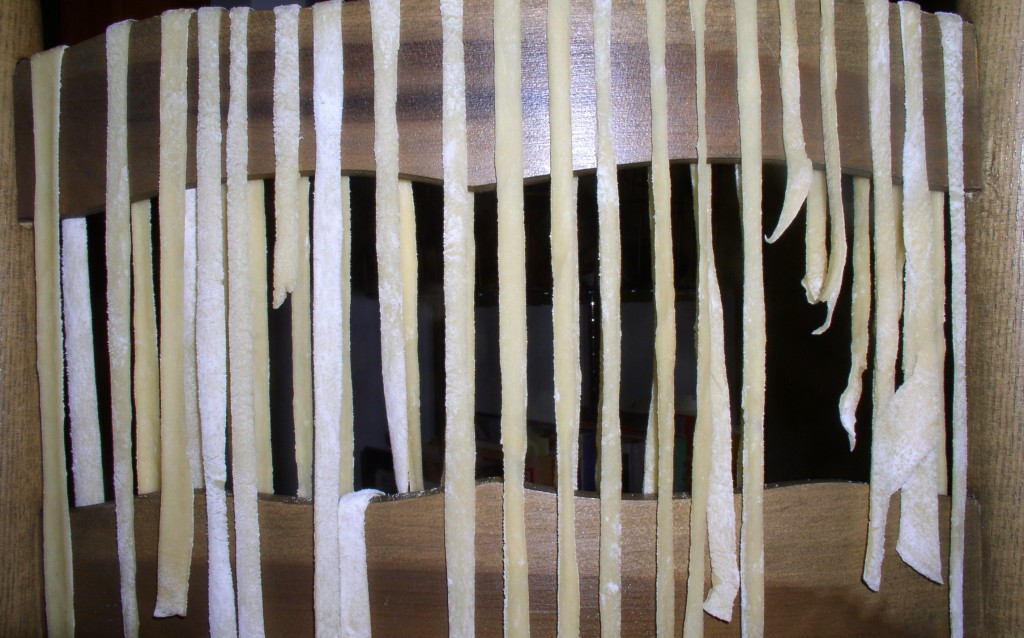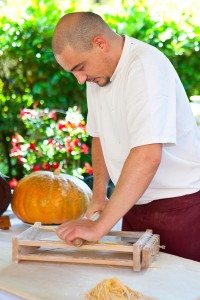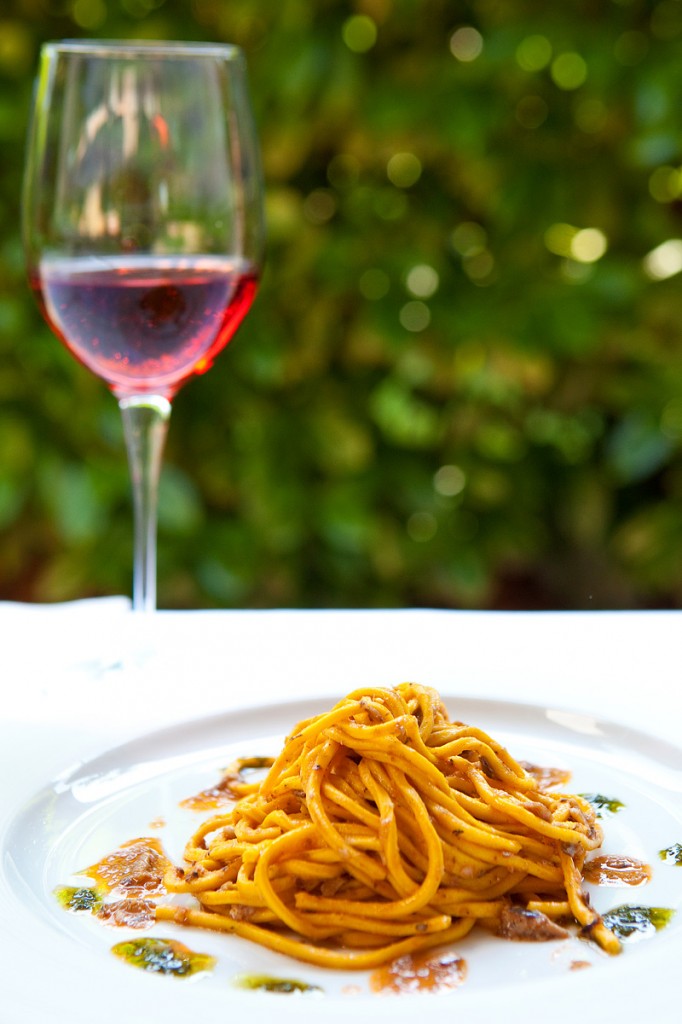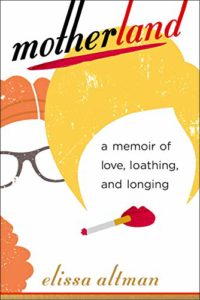I awoke at 2 am this morning, dreaming of pasta.
Not pasta, per se, but the act of making pasta, of making a ragged dough by dumping a heap of flour onto a kitchen table (not mine) and forming a well, adding eggs and a pinch of salt, kneading the dough into a rectangle, and then trying to push it through the stainless, clamp-on pasta maker that we got two of when we got married back in 2003. In my dream, the dough is rough and almost stringy, and when I guide it through the machine and crank it out to make thinner and thinner sheets, it comes out pocked with holes, torn, unworkable, and sad.
This is the time of year when I start to dream of pasta, which I am just this side of forbidden from eating unless it’s the heavy, dark, nutty, whole grain stuff whose health benefits are invariably mitigated by the sheer amount of butter, cheese, and pancetta I have to toss it with to make it remotely edible. Maybe this is an Italian secret: give the pasta—flour, water, egg, salt—most of the attention and go very easy on the extra ingredients, and eat the whole thing in very (by American standards) small quantities. And stop worrying so much.
We don’t really eat pasta very much in my house anymore, mostly because of health concerns; we worry about my borderline diabetic father and mother; the raft of diabetic great aunts and uncles on my mother’s side; the heart disease and sugar sensitivity on my father’s side; and my own potential for heart problems. We worry about the fact that Susan was adopted, and that we know nothing of her genetic makeup. So rather than do the smart thing—cut back, but still enjoy—we do what most Americans do, and deprive ourselves, completely.
I grew up around pasta, although not because I’m Italian (I’m not); in Forest Hills, we had a remarkable Italian restaurant a few blocks from my house, called La Stella, where I was introduced at the age of six to off-the-menu dining. Our regular waiter, Salvatore, asked if I liked bacon, and I enthusiastically shook my head yes. Moments later, he returned to the table with a shallow bowl filled with bucatini all’amatriciana, which he put down in front of me. He shaved on a bit of Pecorino Romano and motioned for me to take a bite; this gorgeously simple, Roman amalgam of meat, salt, chewy pasta, onion, red pepper, and tomato changed everything for me. (That the meat was guanciale, not bacon, opened my eyes to rustic cuts: Salvatore misspoke when he called it bacon, but he probably wouldn’t have been able to sell a Jewish American six year old on cured pig’s jowl.)
Where I grew up, I was more or less surrounded by spaghetti and meatballs, which is a dish I loved, and still do. But that moment at La Stella booted up my internal hard drive: pasta could be a glorious foil for a light dressing of the right meat, the right cheese, a bit of butter or oil, all in far smaller proportions than I was used to. Over the years, until La Stella closed, Salvatore would teach me about crespelle alla fiorentina; lasagnette; tortelloni al burro e formaggio. All arrived in small portions, and all were dressed with a delicate, loving hand. One night, my mother ordered pasta for her second course, and Salvatore simply said, “No, Signora. You’ve had enough.” She became quietly incensed, and thought he was commenting on her girth (she weighed 115 pounds at five foot seven, and still does). She opened the top button of her bell bottoms, ordered a club soda, and fumed.
This time last year, I was three months shy of a major layoff from my job as associate editorial director at the world’s largest publishing house (I say major because it would be one of those deals where they brought the entire department—12 of us—into a room, and told us they were liquidating our group) and simultaneously getting ready to go on a trip to Parma, as a guest of the Consorzio del Prosciutto di Parma. As my colleagues and I packed up our boxes, some tearfully, all I could think of was Italy, and that I was leaving behind my windowless, airless office to concentrate on my life in food, as I’d done many times before, and I was kicking off this newish part of my life (again, as I had done many times before), with a trip to a country I loved.
“What are you going to do–?” one of my colleagues said, wiping away a tear.
“I’m going to Parma,” I responded, “to eat.” And off I went, out the doors of that creaky old building, whose regular lunch offering of stuffed shells in marinara sauce more than once gave me food poisoning, and never looked back.
I had been to Florence and Rome and Milan and parts of Piemonte; I had seen the Duomo and gotten stuck in St. Peter’s during the 2000 Jubilee—just me, Susan, and a few thousand Catholic pilgrims on a Sunday in the pouring rain. I rented a house in Rapolano Terme, twice. I made sugo from local cinghiale that days before had been having wild, noisy, snorting sex in the woods behind our house. I met wonderful people, and saw wonderful things, and tasted remarkable food.
But until I got to Parma—quiet, doable, walkable, ancient, delicious Parma—I had never tasted what happens when a simple pasta dough of flour, egg, and water is created in your presence, rolled out over a Chitarra, boiled for a few seconds, tossed with a little bit of buttery meat sauce and cheese, and then served immediately. As a guest of the Consorzio, I was fed extraordinary dishes by local chefs, many of whom were bent on utilizing the area’s prized ingredients—Parmigiana Reggiano, Balsamico Tradizionale, and Prosciutto di Parma—in unexpected, often fancy ways. Maybe they thought that all Americans eat this way, that we want meals that use indigenous, ages-old ingredients that are then modernized, “pushed to a new level,” and maybe even dusted with crushed candied violets. And honestly, there’s probably a place for that.
But one late afternoon, when I (along with my colleagues Kim Sunee and Rowan Jacobsen) was taken by car to a small country restaurant, Trattoria Ai Due Platani, everything changed for me, again. Sure, there was the torta fritta, the Prosciutto di Parma, and the seemingly endless bottles of Malvasia and Lambrusco. But there was also the chef/owner, Matteo Ugolotti, and the things that he did with that Chitarra of his. Okay, he’s gorgeous in that uniquely Italian male gorgeous way, and that always helps (even if you bat for the other team, the way I do—after all, I’m gay; I’m not dead). But Matteo’s spaghetti alla Chitarra jettisoned me back to those days at La Stella in the late 1960s, when my six year old self was introduced to, and fell in love with, the purest of pure pastas, treated carefully and lovingly—like it was a million dollar bowl of sliced truffles from Alba—and then served in small, sane, reasonable portions.
I don’t know what my dream meant—that I should take the time to make pasta from scratch, and only have it come out raggy, and full of holes, and totally unworkable. But I do know this: We live in a world of speed, of food as fuel, of the dinner buffet and the bottomless pasta bowl served by more fast food joints masquerading as restaurants than we can imagine; we equate portion size with excellence on the one hand, and complete self-deprivation with health, on the other. And those of us who think about food as a way of life—we spend our days and nights searching for the culinary middle way, the gray area, where pasta is made in the most prudent of manners, and a small bowl of it is just enough.
Tonight, that’s what I’ll be making for dinner.







Elissa, I”m thinking YOU should have written the pasta book instead of me ; ) This is a lovely post and I know we are kindred spirits on the subject of pasta. My mother recently gave me her chitarra (from Abruzzo, where that type of pasta originated) and it is probably my most treasured possession. p.s. Can’t wait for you to see the book.
Thank you Domenica–I can’t wait to see it! When is it due out?
I’m not sure there is much that can compete with a homemade bowl of pasta in terms of satisfaction. It is a wonderful meal- even in small quantities.
Also, I’m not sure if you took the photo at the top of the post, but I’m glad to see I’m not the only one who dries pasta in strange places. (To explain: http://themusingbouche.wordpress.com/2011/02/12/papardelle-boar-and-two-bad-jokes/)
Yes Tania, I took it–I realized that I was cranking the pasta, and then had no where to dry it…..
Last night after work I trekked over to Chelsea to get Pasta Setaro at Buonitalia, the only place I know of in NYC that carries it. I got rigatoni, spaghetti, linguine, and, my favorite, spaghetti chitarra. It’s dried, not fresh like the pasta in your beautiful picture, but it is delicious.
I usually only eat 2 ounces of pasta at a time, which I think is a reasonable amount, and I sauce it very lightly – as the Italians do – generally with my favorite Marcella Hazan recipe for tomato sauce made with butter and an onion. I can’t swear to it, but, unless my memory fails me, I believe in Transition to Vegetarianism, Dr. Rudolph Ballentine extols the virtues of a small amount of butter as a source of butyric acid, which, he felt, could be a cancer-preventing agent. He practices holistic medicine so that might not appeal to you, but when I read it, I thought Transition to Vegetarianism was a good book; it was the first time I had heard of trans-fat, and that was a long time ago. Cooked tomatoes are supposed to be a good source of lycopene, apparently, an antioxidant.
But I’m not a doctor or a nutritionist or, even, a vegetarian; just a person who likes to eat well and believes everything in moderation.
Including moderation.
I’m so happy to have discovered your blog.
I’m so used to opening a package and making an enormous pot of pasta in minutes that when I was at a friend’s house and she made it by hand, I was so surprised at how long it took, how perfect it was, and how I didn’t need a heaping bowlful to enjoy it.
Thanks so much Molly. What did you make?
eating in rome last week was the first time i’d had *non* whole grain pasta in several years. i won’t lie, it was exceptional–especially the cacio e pepe, but i’d encourage you to try the hodgsons’ mills angel hair. i know it has a different kind of ethos than you’re seeking, but it adds another dimension to the pasta. i bought a case off amazon, come down to BK and i’ll give you a box to try
Quinoa pasta is great. Try it. Much better than the cardboard kind. I also worry about diabetes II.
I grew up with my grandmother making noodles almost every weekend to put in her chicken soup. She was an old farm girl of German descent; she rolled the dough out with a rolling pin, then rolled the big sheet into a tube and cut long noodles that dried on her ironing board in her living room. It’s the only recipe I can make without measuring. Thanks for making me think of her.
Thank you for linking my blog.
Greetings from Italy !!!